
The World Bank estimates that 62% of fish for human consumption will come from aquaculture by 2030, dominated by tilapia, carp and catfish: Global tilapia production alone is expected to almost double to 7.3 million tons a year by 2030. Read on to discover what our robot, Athena, thinks the future of seafood could be, take action accordingly, or click any link to read the evidence.
Summary
The reality of a world with finite resources and a global population that is projected to hit 9.8 billion people by 2050 is playing an equally significant role in seafood consumption growth.
The global blue economy, which covers all activities making use of the ocean's resources - from fisheries, to renewable energy to biotechnology, is set to grow at twice the rate of the mainstream economy by 2030.
The share of farmed species in global fishery production is projected to exceed that of wild species for the first time in 2020 and to grow to 54 percent in 2030. In Asia, a booming population will account for much of the global rise in beef, poultry and fish consumption over the next decade or so.
World food fish consumption in 2030 is projected to be 20 percent higher than in 2016 with most demand coming from Asia and North America.
Assessing climate change impacts for fisheries and aquaculture primary production of the global ocean is expected to decline by 6 percent by 2100 and by 11 percent in tropical zones.
11% of the world's population will be vulnerable to micronutrient deficiencies by 2050 if there is not a shift in fishery management practices.
In the coming years, the world's oceans will see a growing development of marine infrastructures including offshore wind farms, marine aquaculture farms and offshore ports.
By 2025, Athena finds that the demand for fish will require substantial investment in infrastructure and the use of robots (satellites, sensors, drones, mini-submarines and AI and ML) to track, manage fish and clean their waters. Global efforts are already well underway to create such networked animal management systems.
Growing global populations will raise demand for fish and other seafood.
Attitudes to seafood are positive over the coming years but this may change if supply does not keep up with demand.
Unsustainable fishing practices threaten long-term global food security, especially in the developing world where 60 per cent of people obtain more than 30 per cent of their protein supply from fish.
Athena calculates that the tipping point for the transformation of seafood worldwide will be around 2035 from aggregating the views of all her sources. (The tipping point is when 33% of citizens believe that what changes have occurred have always been the status quo of modern living).
Similarly, those same sources collectively rank the issue as High. She ranks the future Impact in Billions with 35.7% of sources placing it in an already evolving and gaining traction state.
China's future policy and reach in food and agriculture will likely critically impact on world fish supply and demand.
China and Canada lead efforts in future seafood production and supply with the USA, Denmark, New Zealand and India in the van. Given the rapid improvement in supply chains we may well see global competition with players seeking growth far from their shores.
Analysis
Systems map

The reality of a world with finite resources and a global population that is projected to hit 9.8 billion people by 2050 is playing an equally significant role in seafood consumption growth.
The global blue economy, which covers all ctivities making use of the ocean's resources - from fisheries, to renewable energy to biotechnology, is set to grow at twice the rate of the mainstream economy by 2030.
The share of farmed species in global fishery production is projected to exceed that of wild species for the first time in 2020 and to grow to 54 percent in 2030. In Asia, a booming population will account for much of the global rise in beef, poultry and fish consumption over the next decade or so.
Radar
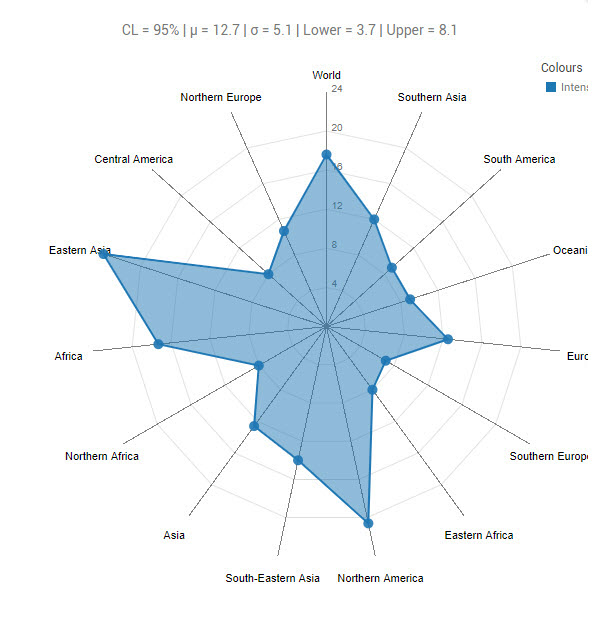
World food fish consumption in 2030 is projected to be 20 percent higher than in 2016 with most demand coming from Asia and North America.
Graph-It

Assessing climate change impacts for fisheries and aquaculture primary production of the global ocean is expected to decline by 6 percent by 2100 and by 11 percent in tropical zones.
11% of the world's population will be vulnerable to micronutrient deficiencies by 2050 if there is not a shift in fishery management practices.
In the coming years, the world's oceans will see a growing development of marine infrastructures including offshore wind farms, marine aquaculture farms and offshore ports.
By 2025, Athena finds that the demand for fish will require substantial investment in infrastructure and the use of robots (satellites, sensors, mini-submarines and AI) to track, manage fish and clean their waters. Global efforts are already well underway to create such systems.
Sentiment analysis
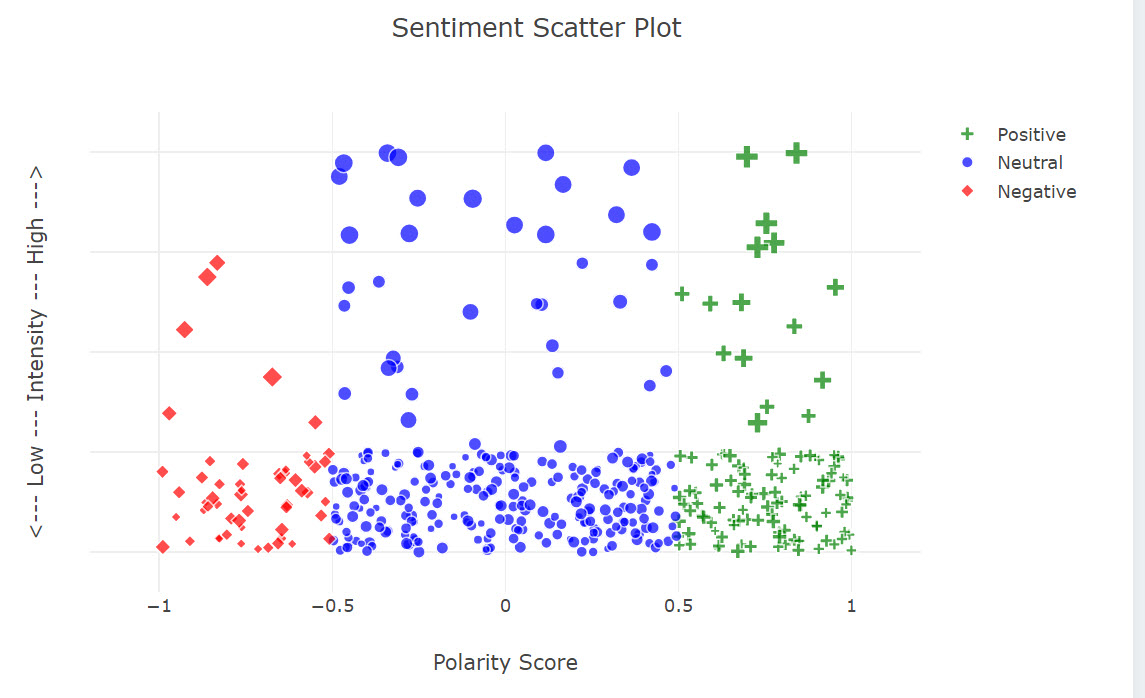
Growing global populations will raise demand for fish and other seafood.
Attitudes to seafood are positive over the coming years but this may change if supply does not keep up with demand.
Unsustainable fishing practices threaten long-term global food security, especially in the developing world where 60 per cent of people obtain more than 30 per cent of their protein supply from fish.
FAO's report warns that the world has diverged in its approach to sustainable fisheries, with worsening overcapacity and stock status - too many boats chasing too few fish - in developing countries offsetting improved fisheries management and stock statuses in developed ones.
Escapes from, or invasion into, aquatic ponds may mix the genomes of wild and cultivated fish, crustaceans, molluscs, aquatic plants, algae, and other organisms with unknown consequences for the industry.
Pie charts
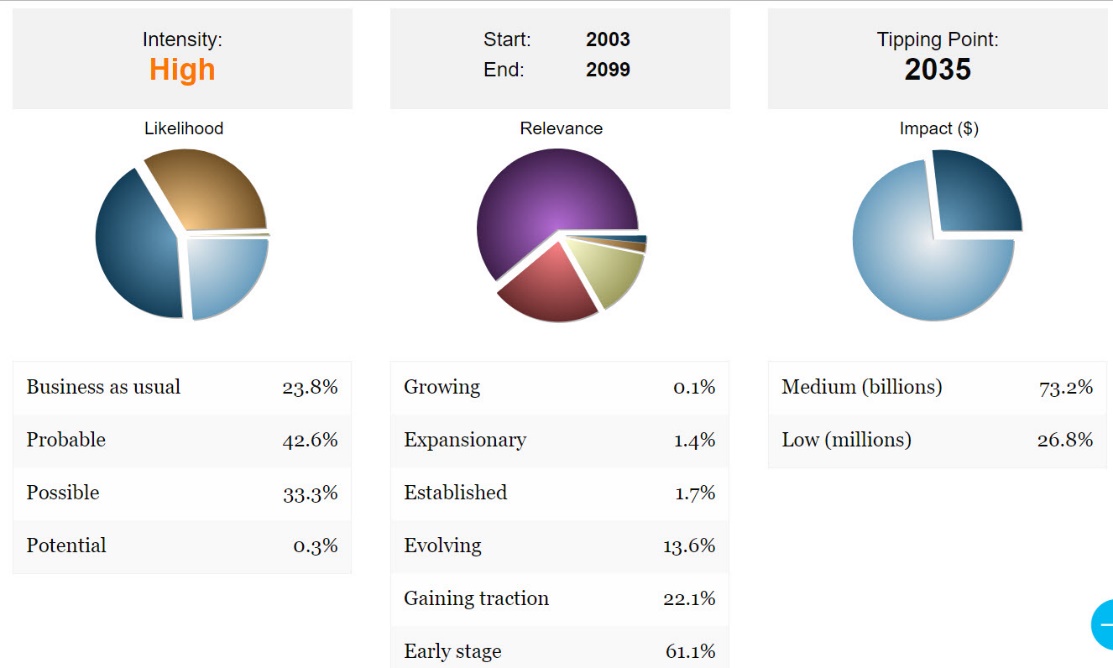
Athena calculates that the tipping point for the transformation of seafood worldwide will be around 2035 from aggregating the views of all her sources. (The tipping point is when 33% of citizens believe that what changes have occurred have always been the status quo of modern living).
Similarly, those same sources collectively rank the issue as High. She ranks the future Impact in Billions with 35.7% placing it in an already evolving and gaining traction state.
Heat Map
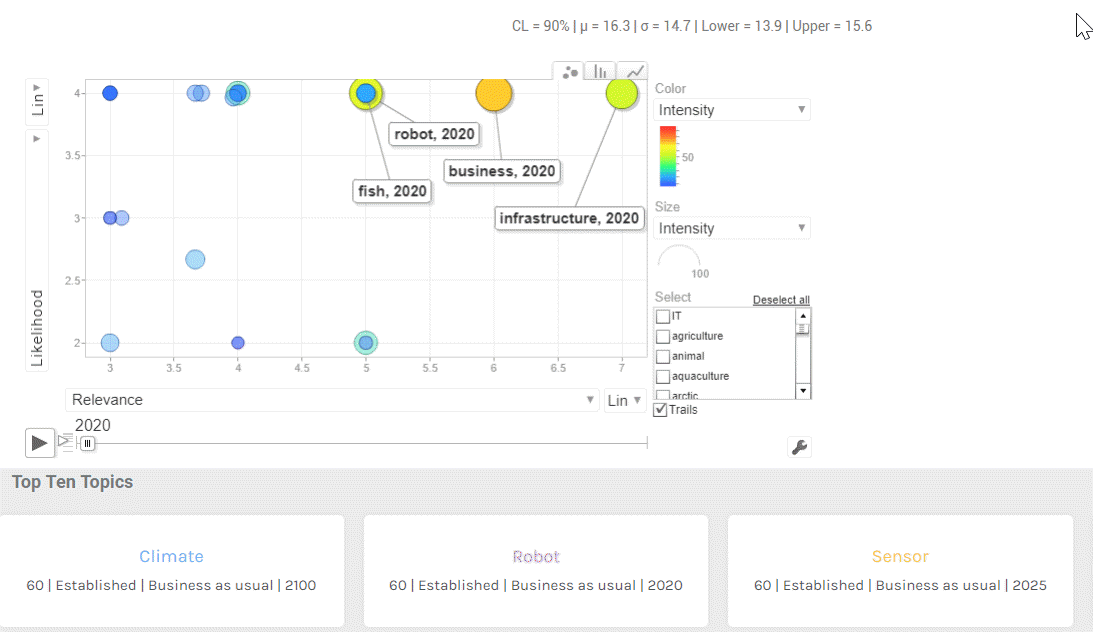
China's future policy and reach in food and agriculture will likely critically impact on world fish supply and demand.
Geographies
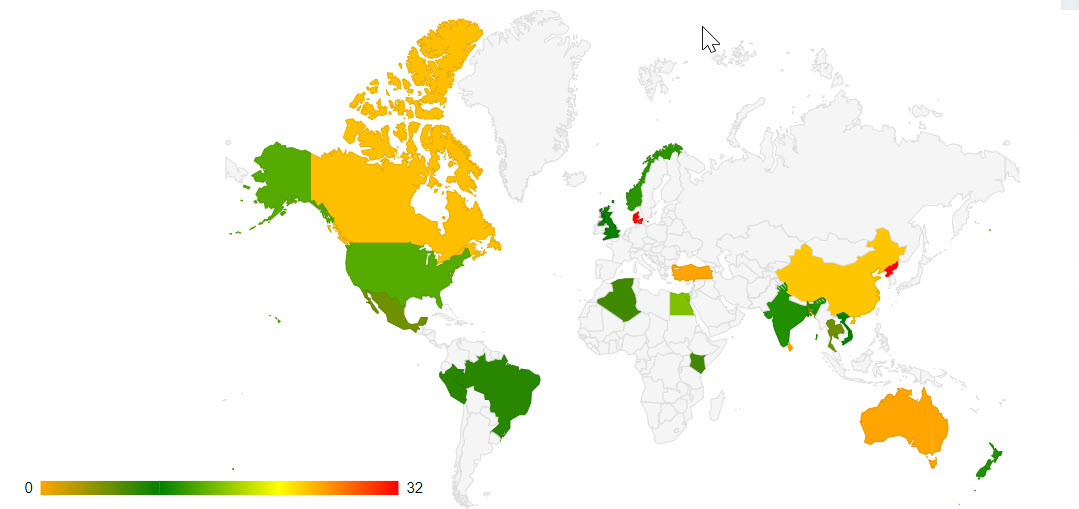
China and Canada lead efforts in future seafood production and supply with the USA, Denmark, New Zealand and India in the van. Given the rapid improvement in supply chains we may well see global competition with players seeking growth far from their region.
Evidence
Extracted forecasts found by Athena and linked back to the original articles, reports and PowerPoints (Insights) that she found can be found below using this search term:
Aquaculture OR aquiculture OR aquafarming OR seafood OR hatchery OR 'blue economy' OR fish
catch
- As marine ecosystems become increasingly nutrient-starved over time, global fish catch could be reduced 20 percent by 2300, and by nearly 60 percent across the North Atlantic.
- Global fish catches could be reduced 20 percent by 2300, with decreases of more than 50 percent across the North Atlantic and several other regions.
- Increasing South Korea's squid catch will require effective enforcement of the ban on Chinese fishing ships in North Korea's EEZ.
- Two-thirds of fish in North Sea and Atlantic fisheries will be subject to sustainable catch limits next year.
- Reforming management of the world's fisheries could increase the total annual catch by 16 million tonnes and increase annual profits by $53 billion.
consumption
- In Africa, per capita fish consumption is expected to decrease by 0.2 percent per year up to 2030.
- In Asia, a booming population will account for much of the global rise in beef, poultry and fish consumption over the next decade or so.
- In Asia a booming population will account for much of the global rise in beef, poultry and fish consumption over the next decade or so.
- The European Union, Japan and the United States of America will account for 43 percent of total imports for food fish consumption in 2030.
- As production intensifies, the geographical locations of greenhouse gas (GHG) emissions, acidifying emissions, freshwater consumption, and land occupation shift from the immediate vicinity of the farm to more geographically dispersed telecoupled locations across the globe.
- Between 2011 and 2021, global fish consumption is projected to increase by 16%.
- In quantity terms, world trade of fish for human consumption is expected to grow by 24 percent in the projection period and to reach more than 48 million tonnes in live weight equivalent in 2030
- World trade of fish for human consumption is expected to grow by 24 percent in the projection period and to reach more than 48 million tonnes in live weight equivalent in 2030.
stock
- 70 countries will find that they have different fish stocks in their territorial waters by 2100.
- By 2050 there will be no exploitable fish stocks in the Asia-Pacific region.
- If trends continue, there will be no "exploitable fish stocks" for commercial fishing by 2048.
- The National Oceanic and Atmospheric Administration (NOAA) estimates that $32 billion and 500,000 jobs could be added to the economy if all fish stocks were rebuilt.
- UK fisher organisations and campaigners for leaving the EU are hoping that Brexit will give UK fishers exclusive national access to fish stocks that have historically been shared between EU countries.
- The Food and Agriculture Organization (FAO) most recently estimated that approximately 31% of global fish stocks are now in an overfished condition and almost 60% are fully fished and are at risk of overexploitation without effective management.
- Challenges in setting out a future EU-UK fisheries agreement will include joint management of around 100 shared stocks.
- Potentially 90% of the world's fish stocks are threatened by over-fishing.
farm
- As production intensifies, the geographical locations of greenhouse gas (GHG) emissions, acidifying emissions, freshwater consumption, and land occupation shift from the immediate vicinity of the farm to more geographically dispersed telecoupled locations across the globe.
- By 2022, all coastal fish farms that want a new or renewed B.C. tenure will need approval from the Department of Fisheries and Oceans and an agreement with First Nations in whose territory they operate.
- The future of GE fish farming will surely involve larger fish farms, with less confinement, in many different environments.
- In the coming years, the world's oceans will see a growing development of marine infrastructures including offshore wind farms, marine aquaculture farms and offshore ports.
- Environmental groups said they support the NDP's criticism of open-pen fish farms and a new requirement for Aboriginal consent, but the 2022 deadline is too far off and threatens to further endanger coastal salmon with the risk of disease.
market
- Technavio's analysts forecast the frozen food market in Europe to grow at a CAGR of 3.85% during the period 2017-2021.
- The global aquaculture market was valued at $176.5 billion in 2017 and is expected to grow at an annual rate of 4.5% to reach a market size of $219.4 billion by the year 2022.
- The global seafood market is expected to be valued at $155.3 billion by 2023.
- Significant growth is expected due to increased awareness of the health benefits of fish oils, and global revenues are expected to nearly double by 2021: Changing health and wellness trends in China and Japan mean that Asia Pacific is likely to be the fastest - growing market up to 2025.
- The huge market for Invasive Alien Species is turning out to be major threat to India's aquatic biodiversity.
- The APAC region is expected to stay in a leadership position in the worlds fish market in the years ahead.
- The worldwide market for Fish Sauce is expected to grow at a CAGR of roughly 4.1% over the next five years.
fish
- By 2025 the world's oceans will contain more plastic than fish.
- FAO's report warns that the world has diverged in its approach to sustainable fisheries, with worsening overcapacity and stock status - too many boats chasing too few fish - in developing countries offsetting improved fisheries management and stock statuses in developed ones.
- The UK wants tariff free access for agriculture and fish and will sign up to the EU's sanitary and phytosanitary regulatory regime.
- Global fish production will continue to expand over the next decade even though the amount of fish being captured in the wild has levelled off and aquaculture's previously explosive growth is now slowing.
- The United Nations General Assembly proclamation of the UN Decade of Action on Nutrition for 2016-2025 provides an opportunity to raise awareness about the role of fish and to ensure that it is mainstreamed in food security and nutrition policy.
- The United Nations Decade of Action on Nutrition for 2016-2025 provides a critical opportunity to raise awareness about the role of fish and to ensure its mainstream incorporation into food security and nutrition policy.
fishery
- Assessing climate change impacts for fisheries and aquaculture primary production of the global ocean is expected to decline by 6 percent by 2100 and by 11 percent in tropical zones.
- By 2022, all coastal fish farms that want a new or renewed B.C. tenure will need approval from the Department of Fisheries and Oceans and an agreement with First Nations in whose territory they operate.
- Restoration of over-exploited stocks and expansion of sustainably managed fisheries and aquaculture will help ensure long-term global food security, support livelihoods, and promote economic development, especially in Small Island Developing States.
- The global blue economy, which covers all activities making use of the ocean's resources - from fisheries, to renewable energy to biotechnology, is set to grow at twice the rate of the mainstream economy by 2030: For Europe, this could mean 10.8 million jobs and nearly 1 trillion euro in turnover.
- Two-thirds of fish in North Sea and Atlantic fisheries will be subject to sustainable catch limits next year.
ocean
- By 2022, all coastal fish farms that want a new or renewed B.C. tenure will need approval from the Department of Fisheries and Oceans and an agreement with First Nations in whose territory they operate.
- Plastics could outweigh fish in the oceans by 2050.
- Plastic pollution could find its way into our oceans at four times the current rate by 2050.
- Norway, Russia and the United States agreed that no commercial fishing will take place in the high seas portion of the central Arctic Ocean while we gain a better understanding of the area's ecosystems.
- Assessing climate change impacts for fisheries and aquaculture primary production of the global ocean is expected to decline by 6 percent by 2100 and by 11 percent in tropical zones.
population
- In Asia, a booming population will account for much of the global rise in beef, poultry and fish consumption over the next decade or so.
- In Asia a booming population will account for much of the global rise in beef, poultry and fish consumption over the next decade or so.
- The reality of a world with finite resources and a global population that is projected to hit 9.8 billion people by 2050 is playing an equally significant role in seafood consumption growth.
- Seafood represents 17% of the global population's intake of animal protein and 6.7% of all protein consumed: With a global population that is projected to hit 9.8 billion people by 2050, those numbers are only expected to climb.
production
- Already constituting 54% of global supply in 2016, aquaculture shrimp could represent about 60% of global supply if production follows the projected increase through 2020.
- As production intensifies, the geographical locations of greenhouse gas (GHG) emissions, acidifying emissions, freshwater consumption, and land occupation shift from the immediate vicinity of the farm to more geographically dispersed telecoupled locations across the globe.
- An algal oil, will enable the production of the omega-3 fatty acids EPA and DHA without using fish oil.
- Over 87 percent of the increase in aquaculture production in 2030 will originate from Asian countries: Asia will continue to dominate world aquaculture production, with a share of 89 percent in 2030.
- Assessing climate change impacts for fisheries and aquaculture primary production of the global ocean is expected to decline by 6 percent by 2100 and by 11 percent in tropical zones.
security
- Rising military ambitions of regional powers all combine to make future fisheries-related conflict a significant threat to global peace and security.
- The United Nations General Assembly proclamation of the UN Decade of Action on Nutrition for 2016-2025 provides an opportunity to raise awareness about the role of fish and to ensure that it is mainstreamed in food security and nutrition policy.
- The United Nations Decade of Action on Nutrition for 2016-2025 provides a critical opportunity to raise awareness about the role of fish and to ensure its mainstream incorporation into food security and nutrition policy.
- Unsustainable fishing practices threaten long-term global food security, especially in the developing world where 60 per cent of people obtain more than 30 per cent of their protein supply from fish.
Custom Services
We can produce equivalent reports to this one on any topic for just $1,000 (Plus VAT in Europe). Market rates are usually at least five to ten times this price. Or, you can subscribe to our service and make these yourself at will and use the forecasts in private, collaborative workshops to develop your strategic responses in hours rather than the weeks and months of traditional foresight projects using these methods below:
Options | Gapfinder | Causal Layered Analysis | Scenarios | Three Horizons
Do contact us to see how we can help you track emerging uncertainty issues and developments as they are announced or reported.
Source
Athena used the sources below as the top ones to create this report and determined which embedded forecasts are included in this Trend Alert. She found 1,255 forecasts in seconds on the 27th September 2018 to allow us to publish this report in less than ninety minutes. She can turn these into PowerPoint slides and Audio files in minutes too as you wish, or we can prepare a full customized and professionally written brief for you to order covering all these forecasts.
